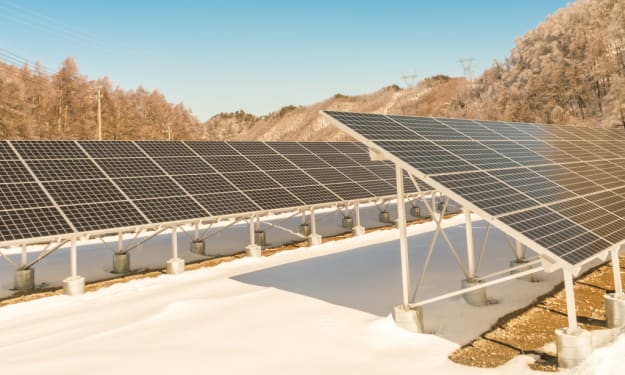No Stranger to Danger
A risky working life

In this-- my fifth year since retiring—I sometimes get asked if I would like to assist in projects being undertaken by my former employer. I’m torn in that some new adventures and very good wages would be welcomed, but I am now 65 and not as spry as I once was, and frankly I doubt if my wife would let me. She has become the 'Idiot Light' that shines bright when I’m about to do something reckless, and she has my history to look back on to help drive the point home for me. This tale is one of those past experiences.
“Hold on - This may get a bit dicey,” said the pilot sitting to my left in the Bell 206 Jet Ranger.
It was late November sometime in the early 1980s before private satellite TVRO systems came onto the public market. Back then in the vast wilderness of the Yukon, off-air community television was one channel – CBC distributed via a network of stand-alone repeater sites that lived on mountain tops that served local communities and their surrounding areas. These sites were powered by thermal-voltaic generators that ran on propane fuel. Eight one-hundred pound bottles of propane would power the site for approximately six months unless cold temperatures caused fuel consumption to increase, that was the reason we had to brave limited VFR flight conditions; the site had run out of fuel terminating all television viewing for the community.
I was sent to make a temporary fix to get the TV transmitter site broadcasting once again so the citizens of Carcross Yukon - some 1200 feet below - could watch game four of the Stanley Cup Playoffs. The weather was on the margin of scrubbing the job until conditions improved. From Whitehorse I drove south to Carcross airport with one hundred pound bottle of propane and my small box of tools. I had arranged to meet the chopper at the community airport at the base of the mountain and upon arrival about half an hour later, the pilot Brian and I took stock of the area and noted the challenges to complete this job safely.

It was about 15 below the freezing mark, overcast with a light breeze coming out of the south, Nares Lake at the base of the mountain was not fully frozen and the breeze was pushing the moisture-laden air up the side of Caribou Mountain to where the repeater site was located. This moist air would freeze on any exposed metal producing hoarfrost that would grow to huge volumes, a crust of ice 20 inches in diameter would cling to a steel cable as thick as a pencil. The ice sometimes became so thick it would attenuate the transmitted signal and diminish the quality of the TV image or become so heavy it would break the antennae off due to the added weight. We had to visit some sites – like Caribou Mountain -- more frequently than others due to the hoarfrost issues. Apart from the impacts to the repeater site, this heavy hoarfrost is a key consideration for maintaining safe aircraft operations.

Brian decided that it would be prudent to go look before we committed to our plan, but we would go prepared to finish the job if conditions were agreeable when we got there. He had just flown the eighty kilometers from Whitehorse and was somewhat confident it would not be too much of a challenge for the chopper, but I would have to work fast as he was not going to shut the chopper down once we arrived at the top. He was concerned about the metal on the machine gathering hoarfrost, increasing the weight and perhaps limiting rotor control functions. So up we went picking our way through the slight cloud cover to the top. After a fly-around inspection we determined that conditions were not all that bad and Brian then sat the machine down into the snow close to the transmitter shack. I grabbed the shovel I had placed in the back seat of the chopper next to the solitary propane bottle and began to dig out the door that accessed the shack. Twenty minutes later and with a good sweat on, I opened the door.
Returning to the chopper I hauled out the propane and my toolbox and dragged the bottle into the shack. It took me all of five minutes to replace one of the empty bottles with the full one. I then lit the Telan generator with an iffy Bic lighter and saw the needle on the voltage gauge slowly beginning to rise. It would take some time for the generator to get up to operating temperature and supply enough power to the transmitter before I could confirm proper operation.
I felt Brian tapping me on my shoulder, turning to face him he gave me the Let’s Go! sign. So without confirming the transmitter would function once again, I gathered my tools, shut the door of the shack and followed Brian back to the machine. When the bush pilot says its time to go - you go, because it’s a long chilly walk back down the mountain.
Approaching the Jet Ranger I noticed there was about an inch and a half of hoarfrost on the thin ELT antenna mounted on the front of the cabin. The collective mechanism at the top of the rotor was also white with frost. The rotors were still slowly turning, and the heat of the engine causing frost to melt and run down the sides of the shroud.
Safely strapped in my seat after stowing the empty propane bottle and my tools, and ready to lift off is when Brian told me to hang on and be ready for dicey conditions. He was not kidding either. With just the two of us on board, it took close to 100% power to lift the machine free of the snow and rise slowly. I watched chunks of ice being thrown to the distance by the rotor blades as Brian oriented us to a narrow valley that ran down the west side of the mountain. He brought us to the cliff edge to have a look down to confirm visibility which was not too bad, and down we went, flying only about forty feet from the surface, the prop wash causing a cloud of lite snow to obscure visibility somewhat. I could faintly see Ptarmigan hiding under the sparse willow bushes as we made our way down the mountainside as if skiing. I glanced at Brian and he was cool and calm as always - he is one of my favourite pilots in either rotary or fixed wing aircraft.
In what seemed like seconds we were approaching the runway at the small community airport, Brian flared the machine before landing and more ice flew off the chopper, some hitting the company van parked nearby. During a helicopter landing, a flare is a maneuver used to reduce both vertical and horizontal speed to allow a near zero-speed touchdown. Safely on the ground once again, Brian shut the machine down as he had to perform an inspection for damages and any lingering ice before he could fly back to Whitehorse.
“What have you got planned for the rest of the afternoon?” he asked as I retrieved my tools from the back seat. “Cause I’m going to sit in the lounge of the Airport Inn and have a few. You have no idea how close we came to disaster.” Still the calm and relaxed fellow he smiled at me. Again, when the bush pilot says it was a close call--it was a very close call.
So Brian and I spent a few hours getting to know each other a little better while slurping single malt whiskey after he got the chopper back in the hangar, and I traded the company van for my own truck.
As I do not drink and drive, later that afternoon I called my wife to come pick me up and as expected, she was not thrilled to learn why I was drinking in the mid day. Adding this incident to a couple previous hard landings in choppers and float planes, she pressed me to give up field work for something safer. So, a few months later I moved upstairs into sales and marketing where I got fat. I really did miss field work and being out in the vast sub-Arctic wilderness braving the elements and installing telecommunications systems for a variety of cliental.
I got paid to travel to exotic remote northern places that people today pay dearly to visit and experience. While working in the Kluane Park area on a mountaintop, young Dall sheep would be sniffing in our toolboxes unafraid as we were quite probably the first humans they had ever seen. We watched from the safety of a helicopter as the name sake grizzly of the Golden Bear Mine south of Atlin B.C. tore apart a repeater box we thought would be bear-proof - we were wrong. One trip into the far north we had to land the Twin Otter on the frozen tundra, roll a couple fuel drums off the plane and pump the fuel into the plane as a group of caribou watched from some distance. Then we put everything back into the plane and resumed our travel to the destination before it got too dark.

Oh, the TV transmitter did get up to speed and function as designed providing the hockey fans of Carcross with their play-off game. I think it was Calgary that won, but I don’t follow hockey so who really cares?
About the Creator
Doug Caldwell
I hope to learn from all of you members on this site and share in some tale-telling. I am looking forward to the different styles used to tell these stories. I look forward to reading yours.
Be Well






Comments
There are no comments for this story
Be the first to respond and start the conversation.